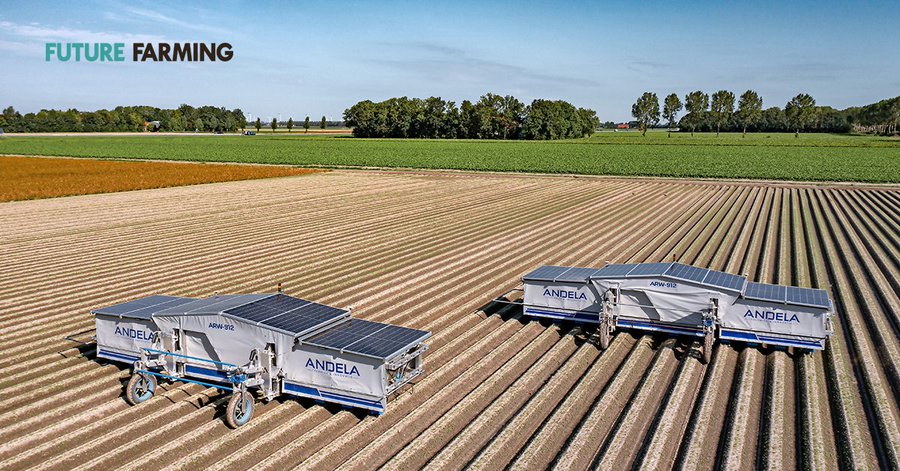May the best robot win!
Future Farming (a media enterprise) and World FIRA (International Forum of Agricultural Robotics) are hosting a competition to appoint the most promising agricultural robot at a show in Toulouse, France, in February. It is the second year of the competition and out of twelve monthly contenders these five machines made it to the final round to be considered for the award as Ag Robot of the Year. (Source: Future Farming)
The ARW-912 is a fully robotised weeding machine with 12 weeding units and a working width of nine metres suitable for row crops. Each unit has a camera that detects the weeds and controls the linked robot arm, which kills the weeds with a probe while the soil remains undisturbed. The image recognition system can detect and kill weeds from a very early stage. The machine runs on solar panels, is electrically powered, and runs on tracks with RTK-GPS control. The ARW-912 can be used 24/7 and records all the data with images as it goes along.
Digital Workbench Tipard 1800
Tipard 1800 is an autonomous multi-carrier platform for the automation of entire process chains in the field, from seed drilling, fertilising, weed and pest control to harvesting. It has 12 hours working time on electrically charged batteries, but can also run on diesel. The main frame has seven modular sub-frame spaces that can be equipped with various diesel engines up to 40 kW, auxiliary fuel tanks, battery modules with up to 56 kWh battery capacity, a three-point hitch or various sensor units. There are five implement mounting options.

Ekobot WEAI
WEAI works with high precision which is especially important in rows of vegetables. The robot has mechanical arms to remove weeds between rows and a hoeing system to remove weeds in the rows. In this way you also reduce the use of herbicides so the farmers can reduce their costs and contribute to a healthier environment. Tests in Sweden showed that the robotic system can contribute to higher yields compared to conventional cultivation using herbicides. The robot uses RTK-GPS to navigate with 2 cm precision.

Tensorfield Agriculture Jetty
Jetty performs herbicide-free precision thermal weeding in high density row crops such as carrots and spring mix. It identifies weeds among crops, using computer vision. It then sprays a microdose of organic-approved high temperature vegetable oil onto the weeds with sub-cm precision to kill the weeds and allow crops to flourish. According to Tensorfield, Jetty delivers the quickest, most cost-effective method of getting a precise lethal dose of heat energy into a weed, to kill the weed in a targeted fashion among post-emergent crop foliage.

Tortuga AgTech F and G
Tortuga’s platform combines artificial intelligence, purpose-driven design, and on-the-ground operations. The robot is primarily designed for harvesting but can also collect data for forecasts, treat plants with UV-C light and perform trimming. Every robot has an autonomous base that navigates up and down the row and two arms that identify, move, and pick fruit. The robot’s AI uses nearly twenty “models” to make picking decisions, relies on advanced software for two-arm picking and navigates in the row precisely.

In other news
John Deere reaches for the stars
Deere & Company has entered into an agreement with SpaceX to provide satellite communications (SATCOM) service to farmers. Utilising the Starlink network, this solution will allow farmers facing rural connectivity challenges, to leverage precision agriculture technologies.
“The value of connectivity to farmers is broader than any single task or action. Connectivity unlocks vast opportunities that were previously limited or unavailable,” said Aaron Wetzel, Vice President of Production and Precision Ag Production Systems at John Deere. “For example, throughout the year, farmers must complete tasks within extremely short windows of time. This requires executing incredibly precise production steps while coordinating between machines and managing machine performance. Each of these areas is enhanced through connectivity, making the entire operation more efficient, effective, and profitable.”
The SATCOM solution will connect both new and existing machines through satellite internet service and rugged satellite terminals. This will fully enable technologies such as autonomy, real-time data sharing, remote diagnostics, enhanced self-repair solutions, and machine-to-machine communication, all of which help farmers work more efficiently while minimising downtime.
“John Deere has been in the agriculture equipment industry for more than two decades with satellite-based precision guidance technology,” said Jahmy Hindman, Senior Vice President and Chief Technology Officer at John Deere. “Now, we are bringing satellite communications service to the farm at scale so farmers with cellular coverage challenges can maximise the value of connectivity to their operations.”
John Deere’s SATCOM solution will leverage SpaceX’s Starlink satellite internet constellation. To activate this solution, John Deere dealers will install a Starlink terminal on compatible machines, along with a 4G LTE JDLink modem to connect the machine to the John Deere Operations Centre. The SATCOM solution will initially be available through a limited release in the United States and Brazil starting in the second half of 2024.
Unfortunately for South African farmers it may be quite sometime before Starlink will be welcomed in this country










